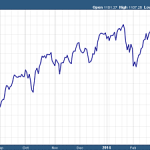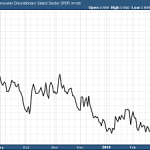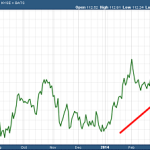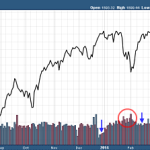Will There Be A Recession? The Stock Market's Offering Some …

by Raul de Frutos
The relationship between the stock market and metal prices changes from time to time. However, when the stock market plunges, history repeats itself and as fears of an economic downturn increase, consumer spending decreases and metal prices fall with the stock market.
It’s in these situations when buying forward can become riskier than not hedging at all. Companies can lose a lot of money when they get caught holding expensive inventories as demand shrinks and metals prices drop. Therefore, buyers need flexible procurement strategies so they can adjust depending on the state of the market.
The stock market is without a doubt the best indicator of the U.S. economy. The market usually tops way before economic reports indicate that the economy is in trouble. Today, we study three facts warning that we might be entering a recession sooner rather than later:
1. Money rotating into safer stocks
Russell 2000 Small Caps Index since 2013
Generally speaking, small caps are more sensitive to turns in the economy than large caps since smaller stocks are affected by economic weakness more quickly. Many stock leaders and small stocks have begun to break down this year, showing signs of overall economic weakness. The chart above shows the Russell index (includes 2,000 small securities) weakening since March this year. The NASDAQ Composite index, which is mostly based on small and entrepreneurial companies, is showing similar behavior. Further declines of these indexes will cause us to worry.
Relative strength ratio: Staples vs. Cyclical stocks
The chart above shows a ratio comparing consumer staple stocks (the least economically sensitive stocks) versus consumer discretionary stocks (very economically sensitive stocks). We can see how consumer staples are outperforming cyclical stocks since March, meaning that investors have already started to move their money into safer stocks.
2. Money flowing into bonds
TLT)”/>
20+ Year Treasury Bond ETF (TLT)
Not only has money rotated out of these riskier stock groups into larger and safer-value stocks, but some of that nervous money has also been moving into bonds. When fear rises, investors move their money from stocks to bonds. Bond prices and stocks move in the opposite direction, especially in recessions when bond prices always increase before the market plunges. The chart above shows how bond prices have surged since the end of 2013. This is not a good sign for the U.S. economy.
3. Signs of distribution
Although the S&P 500 (based on large companies) is holding better than other market indexes, it is also showing signs of weakness. The index is struggling to make new highs and it is showing signs of distribution.
S&P 500 Index since 2013
In the chart above we can see how the index seems to be running out of steam and rolling over on heavier volume. Larger volume in down days (red circles) warns that professional investors are liquidating stocks, while the up moves are occurring on dry volume trading days (blue arrows) signalling a lack of bullish sentiment.
What This Means For Metal Buyers
Historically repeated events are pointing to trouble in the U.S. stock market. No one knows what the catalyst will be, but eventually there will be an inflection point, and the market will snap. It is really hard to know how severe the next market correction will be, and how much of an impact it will have in your business. However, buying organizations should look back to 2008 and see what they could have done better and be prepared for the next decline in economic activity. Stock investors might also want to start raising cash and protect their money at this point.
Source:
Will There Be A Recession? The Stock Market’s Offering Some Scary Clues
See the original post:
Will There Be A Recession? The Stock Market's Offering Some …
See which stocks are being affected by Social Media




